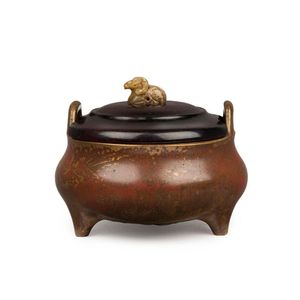Qing Dynasty Bronze Censer with Xuande Mark
A bronze censer Qing Dynasty, 19th century, the squat body supported on tripod conical feet and set on the slightly flared mouth with two loop handles, the exterior with marbled reddish and bronze patina, the base with an apocryphal six-character mark of Xuande in a cartouche encircled with two dragons chasing a flaMing pearl in relief, fitted wood cover, 11 cm diameter
You must be a subscriber, and be logged in to view price and dealer details.
Subscribe Now to view actual auction price for this item
When you subscribe, you have the option of setting the currency in which to display prices to $Au, $US, $NZ or Stg.
This item has been sold, and the description, image and price are for reference purposes only.
- Cartouche - An ornamental panel in the form of of a shield, oval or rectangular scroll with curling edges. It may be carved into the back of a chair or the top of a sideboard, or present on a piece of silver or jewellery, and contain the initials of the original owner, heraldic symbols, or some other inscription, such as the details of a presentation.
In ceramics the term defines the central area of a vase or similar with a decorative border in one of the shapes above, into which a decorative scene or figures have been painted. - Marbling - A descriptive term for a finish applied to plastic, ceramics, glass, plaster or wood to imitate the colours and characteristic markings of various marble types. For moulded items such as the first three above, the marbling is within the item.
Interiors and furniture were marbled from from the early 17th century to the late Victorian period. The craft was practiced by skilled decorators using a combination of brushes and sponges. Some of the finishes achieved were so realistic as to make it difficult to distinguish the marbled surface from the marble surface.
Marbling is also a term applied to a finish for paper as often seen in the front and endpapers of old books. The marbling is achieved by floating the colours on water and then transferring them to paper. However the marbling finish on paper, as with the marbling finish on plastics, with its multitude of colours has little resemblance to naturally occurring marble. - Bronze - An alloy of copper and tin, traditionally in the proportions of about 9 parts of copper to 1 part of tin.
The discovery of bronze in Western Asia in the 4th century enabled people to create metal objects which were superior to those previoulsy possible because of its strength and hardness, and it has been used throughout the world for weapons, coins, tools, statuary and other decorative items.
It is very fluid in a molten state, and its hardness, strength when set, and non-corrosive properties makes it most suitable for casting sculpture. - Qing Dynasty - The Qing Dynasty was the last imperial dynasty of China, ruling from 1644 to 1912. It was established by the Manchu people, who originated from the northeastern region of China. The Qing Dynasty was preceded by the Ming Dynasty and followed by the Republic of China.
- Ming Dynasty - The Ming Dynasty was a ruling dynasty of China from 1368 to 1644. It succeeded the Yuan Dynasty and preceded the Qing Dynasty. The Ming Dynasty was established by Zhu Yuanzhang, a former Buddhist monk who became a rebel leader and eventually overthrew the Mongol Yuan Dynasty. During the Ming Dynasty, China experienced a period of relative stability and prosperity. The government was centralized and bureaucratic, with the emperor at the top of the hierarchy. The Ming Dynasty is known for its cultural achievements, including the development of porcelain, the invention of movable type printing, and the construction of the Great Wall of China.
- Patination / Patina - In broad terms, patination refers to the exterior surface appearance of the timber, the effect of fading caused by exposure to sunlight and air over the course of a century or more, changing the piece to a soft, mellow colour.
As patina is very difficult to replicate, it is one of the most important guides to determining the age of furniture.
Patina is also the term applied to the bloom or film found on old bronzes due to oxidisation.
This item has been included into following indexes:
